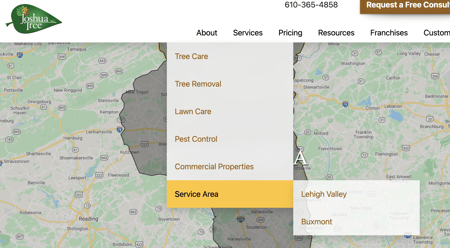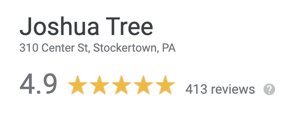Topics: Search Engine Optimization (Seo) Social Media Content Marketing Web Development Advertising Public Relations Branding And Positioning Email Marketing
Multi-Location Marketing Strategy for Landscaping and Lawn Care Businesses
 Author: Lindsey Getz
Author: Lindsey Getz
 Developing an effective marketing strategy that helps your company to connect with prospects in a meaningful way can be challenging enough on its own. But when you start adding in the fact that your landscaping or lawn care business is growing into multiple locations, it can become downright daunting.
Developing an effective marketing strategy that helps your company to connect with prospects in a meaningful way can be challenging enough on its own. But when you start adding in the fact that your landscaping or lawn care business is growing into multiple locations, it can become downright daunting.
For many, the fear is that your messaging will become diluted as it spreads. How can you ensure that you’re able to achieve optimal coverage with consistency—plus effectively use your budget to market all locations?
We understand how challenging it can become to feel that you’re maintaining consistency and implementing highly effective marketing strategies as your business grows. Everything from budgets to brand guidelines to the need for additional technology and people can seem to muddy the waters.
However, it really doesn’t have to be as overwhelming or stressful as it feels. With the right multi-location marketing strategy for your landscaping or lawn care business, you can approach your growth with confidence that everything is under control.
In fact, there are a lot of lawn and landscaping companies that are already effectively doing this. Landscape Leadership has worked with some of the largest multi-location companies in the country—and we spoke with them for this article, asking them to share some of their best advice.
On the commercial side, that includes Level Green Landscaping with five branches in Maryland and Virginia; as well as Yellowstone Landscape, which is headquartered in Bunnell, Florida with 40+ locations around the country.
On the residential side, we spoke to Joshua Tree Experts, which currently has two Pennsylvania locations and is poised for more locations in the next year.
In this article, we’ll share the advice from these companies on creating and adhering to a multi-location marketing strategy—as well as our own expertise and how we’ve guided these companies in this process.
It Starts with a Plan
As you think about marketing for multi-location businesses, it’s important to ultimately come up with a plan.
This will be your multi-location marketing strategy.
Let’s take a look at what a solid multi-location marketing strategy should cover for a lawn and landscape industry company and how some of our Landscape Leadership clients have gotten the most out of theirs.
A Unique Location Page on Your Company Website
It’s important to have a unique page on your website for each location. Let’s look at Joshua Tree Experts as an example. They have a Service Area page, but then they also have a unique page for each of their locations: Lehigh Valley and Buxmont. In order for these website pages to perform and rank well, you can’t just copy and paste the same information onto each.
Let’s look at Joshua Tree Experts as an example. They have a Service Area page, but then they also have a unique page for each of their locations: Lehigh Valley and Buxmont. In order for these website pages to perform and rank well, you can’t just copy and paste the same information onto each.
These pages should be unique and as “hyper-local” as possible. That’s why the Lehigh Valley page, for instance, has an opening photo that shows the SteelStacks in the background as this is a prominent Lehigh Valley location that most local people know.
Other relevant content beyond photos would be linking a few localized blog articles to this specific location page. It goes a step further in making it a valuable experience for the visitors.
Of course, these location pages can become more difficult as you grow larger. Yellowstone Landscape is a national company, so they approach their location pages a bit differently. Rather than every branch having its own unique page, they utilize landing pages for each geographic area, such as Albuquerque, NM or Houston, TX.
Then, the branches are listed for each geographic area.
“These geographic pages definitely need to be very localized,” says Joseph Barnes, director of marketing for Yellowstone. “When a prospective client from New Mexico wants to see the type of landscaping that we do, they don’t want to see a lush, green, tropical resort in Florida. That immediately creates the mindset that this isn’t a company that understands my region.”
The geographic landing pages also feature local projects where visitors can click and read a case study.
“These location pages do a really good job of showing off the type of work that we do in each region,” Barnes continues. “When our salespeople send out a link to our website, they are not linking the homepage, they are linking to these specific location pages.”
Create a Unique Google My Business Listing for Each Location
Another critical aspect to successful multi-location marketing for your landscaping or lawn care business is paying close attention to Google My Business. We all know that Google basically runs the local SEO show and if you aren’t paying attention to your Google My Business page, you’re missing a critical opportunity.
You need to set up each Google My Business page with a unique street address and phone number (even if, on the back-end, it ultimately rings back to a main location).
Of course, some challenges can arise with this goal, which is why it can be helpful to have a marketing agency partner helping you.
Michael Mayberry, Chief Technology Officer for Level Green Landscaping says they experienced some issues with Google contesting their locations—in one case because they didn’t have a mailbox.
“Landscape Leadership was an enormous help to us in making sure our locations were verified with Google,” Mayberry recalls. “They got it all worked out for us.”
You will need to have a physical mailbox to which you can receive mail and it helps to have signage that is visible from the road, as well. Google will sometimes review street views when verifying your location.
Finally, another Google My Business best practice for multi-location businesses is to link each individual GMB listing to its unique, corresponding location page on your company website rather than linking all of your GMB listings to your website’s homepage.
Use a Service Like Moz Local to Maintain Consistency
Software will also be incredibly helpful when setting up your Google My Business page and automatically syncing your company information with popular business directories (SuperPages, YP.com, Hotfrog, etc, etc). We personally like Moz Local and use it with all of our lawn and landscape industry clients.
Consistency across numerous online directories is an important local ranking factor but can be challenging to stay on top of everywhere that your location is listed without some extra support from a tool like Moz Local.
Creating Marketing Assets Unique to Each Location
One of the challenges, but necessities, as a company grows into new locations is to continue to create marketing assets that are unique to that location. This would include things like videos, images, case studies, blog content, customer testimonials, and more. “If you don’t have these assets, you’re just not going to get noticed in that market,” says Level Green’s Mayberry. “Along with that, those assets need to be able to connect to the prospects you’re trying to reach in that new market.”
“If you don’t have these assets, you’re just not going to get noticed in that market,” says Level Green’s Mayberry. “Along with that, those assets need to be able to connect to the prospects you’re trying to reach in that new market.”
Mayberry says a perfect example has been their expansion into Northern Virginia, where data centers are “popping up like McDonald’s.” But Mayberry says that marketing to a data center is much different than marketing to an office space, as they frequently focus on in other areas.
“But if you miss the mark on what that client is looking for, you’re going to miss out on that entire vertical,” Mayberry says. “That’s where Landscape Leadership has been a real partner to us, helping us to determine what content is going to connect best with our prospects as well as what keywords are going to bring traffic to that content.”
These assets are also a crucial part of local marketing strategies for multi-location businesses in that they help even the largest companies to show how they are connected to a local area.
“Photography and video have been absolutely key for us,” says Yellowstone’s Barnes. “Even for our clients who are interested in our national footprint and the work that we can do for national accounts want to be able to see that we do really good work in multiple places.”
Of course, Barnes says they also have prospects who are incredibly hyper-local and only really care about the branch that will be servicing them.
“It has been our challenge that we must take both a micro and macro-approach,” Barnes says. “It’s a delicate balance in figuring out what the prospect cares about but we are focused on marketing ourselves as both a really large company, which has benefits that comes with that, as well as a very localized company that is very committed and connected to the markets that we’re in. Our marketing assets touch both of these and our sales team is selective about what to share with the prospect.”
Generate Customer Reviews for Each Location
Another key part of a multi-location marketing strategy is to put in the effort to generate reviews for your landscaping or lawn care company. “Personally, I look at reviews all of the time no matter what I’m researching whether it be a tool, a vehicle, or a restaurant,” says Joshua Malik, owner of Joshua Tree Experts. “Great customer reviews are a must-have for us not only for reaching prospective clients in a new area but also prospective hires. People want to work for a five-star company, not a three-star one.”
“Personally, I look at reviews all of the time no matter what I’m researching whether it be a tool, a vehicle, or a restaurant,” says Joshua Malik, owner of Joshua Tree Experts. “Great customer reviews are a must-have for us not only for reaching prospective clients in a new area but also prospective hires. People want to work for a five-star company, not a three-star one.”
“These customer reviews help build your company’s authority, even if you’re new to the area so it’s important to get them early on,” Malik adds.
Another best practice: Be sure to generate customer reviews for each of your Google My Business listings. If your company has five locations, each with a unique GMB listing, then you should solicit customer reviews across all five listings, not just one GMB listing.
Have a Paid Search Budget for Each Location
In terms of your marketing budget, we recommend having separate budgets for each of your locations. You will likely need to allocate more dollars to marketing a new location and if it’s all grouped into one budget, you could eat up the whole budget with just one location. Even though you’ll need to spend more in a new market, you don’t want to ignore locations where you are already established.
This approach translates to your paid search campaigns as well (i.e.- Google Ads, Facebook Ads, etc). Each location should have its own unique paid search campaign along with its own budget.
Don’t be afraid to go “offline”.
Joshua Tree’s Malik says that they aggressively went after their new Buxmont location, creating a presence there before even officially opening. That included trying new marketing approaches they’d never used before.
“We learned that billboards are more of a branding tool than a call-to-action tactic, but that was important since we were new to the area,” Malik says. “People didn’t know who we were yet. So, that was one way to establish our name in the area.”
Malik adds that they also invested in lots of door-hanging, attending events, postcard mailers, and wrapping vehicles that would be driving through the area.
“We started marketing in December but didn’t actually open until March, so we were really focused on creating a presence early on,” he explains.
Localize Your Email Marketing
Finally, when it comes to utilizing email in your digital marketing strategy for a multi-location business, you want to make sure that your emails are targeted to prospects and customers in one specific location. Even if you have a more general email that applies to everyone, make sure that the phone numbers are localized and that any hyperlinks included are sending people to local pages.
This is especially important if you are promoting different seasonal offers in different locations.
Overcoming Challenges when Marketing for Multi-Location Businesses
We know this sounds like a lot. But by creating a strategic plan and having a marketing partner who can help execute it for you, it’s absolutely achievable.
Malik says that maintaining consistency within multi-location marketing is imperative as a company cannot lose its brand identity in the process.
“Our messaging, our look, our logo—it’s all consistent, even as we grow,” he continues. “That doesn’t mean we might make tweaks to reach a new audience of prospects, but ultimately, who we are is the same.”
Mayberry agrees, “Making sure that your brand story and assets are cohesive, regardless of location, is critical,” he urges. “We know that when we enter a new market, we’re not going to be well-known there. But we’ve already created formulas that work and we stay true to our brand.”
Mayberry adds that at the end of the day, local marketing strategies for multi-location businesses are partially “replicating what you already know works” while giving attention to anything that might be unique to that market.
“This is where a marketing partner is so incredibly valuable,” he adds. “Those slight changes in the market are not always apparent as we’re busy doing the landscaping work. A marketing partner can dig into what the prospects in that market are really looking for.”
Mayberry sums up: “Though it might feel like it at first, it really doesn’t have to be complicated and stressful. If you have a marketing partner on your side, you can attack your growth with a tried-and-true strategy that works.”
---
Want more insight like this? Join over 5,000 of your green industry peers by subscribing to the Landscape Leadership blog. We'll send new content directly to your inbox. Just add your email address below.




